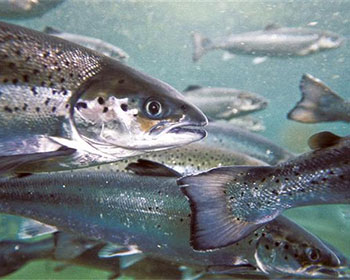|

A new study found no evidence of a negative impact of salmon farms on wild salmon stocks. (Photo: Stock File)
Pollution seems more harmful to wild salmon than aquaculture
 REPUBLIC OF IRELAND
REPUBLIC OF IRELAND
Thursday, July 04, 2013, 03:40 (GMT + 9)
A team of scientists at the Marine Institute have found that Irish wild salmon stocks are more seriously affected by pollution than by fish farming.
The study revealed “no evidence of any negative impact of aquaculture” on wild salmon stocks in Ireland, and it determined that river catchments containing salmon cages close to their estuaries are performing “best” in terms of satisfying wild salmon conservation limits. It also showed a “steady and sustained improvement in the overall status of Irish salmon stocks.”
The findings were published in the peer-reviewed international scientific journal Agricultural Sciences.
Headed by Marine Institute scientist David Jackson, the team analysed reports written by the government’s standing scientific committee on the status of Irish salmon stocks that had been submitted to the Department of Communications, Energy and Natural Resources, Irish Times reports.
According to the data, conservation limits are being met on many Irish salmon rivers and those on the west coast are recovering exceptionally well.
“There is no relationship between the presence of salmon farms and difficulties with rivers meeting their conservation limits,” the paper claims, and “sea lice [is] not being a factor in declining marine survival of wild salmon.”
Further, the researchers determined that fish farm escapees are at a “low level” and “contribute little to spawning stocks” of wild fish.
In fact, the study concludes that the quality of the freshwater habitat may be a “key driver” as far as wild salmon stock survival, with east coast rivers most seriously affected.
Moreover, the study noted that the controversial conservation measures -- like banning drift netting for salmon offshore, closing certain rivers -- introduced in 2007 are helping stock recovery in a period of “low marine survival”.
The Marine Institute has already done a nine-year study of impact of sea lice on wild salmon and found the effect negligible in terms of overall marine mortality. The analysis involved 352,142 salmon at eight locations along the south and west coasts from 2001-9; similar findings were arrived at in a 12-year study in Norway.
"The drive and focus of Europe under the new Common Fisheries Policy (CFP) is to develop fish and shellfish farming and neither industry nor government should be distracted any longer from this important task,” The Irish Farmers’ Association’s (IFA) Aquaculture Executive Richie Flynn said. “We need to fill a huge eight million tonne gap between production and consumption of seafood in the EU using the experience, quality control, environmental management and confident skills of the EU industry to produce world class farmed fish and shellfish."
Minister for Marine Simon Coveney is currently considering a 15,000-ton organic salmon farm proposal for Galway Bay, and environmental group Friends of the Irish Environment (FIE) has lodged a request for “redress of maladministration” by his department, claiming that it “knowingly misled the European Commission in its investigation of sea lice and wild salmon”.
The request opens the door to bringing a case for maladministration to the Ombudsman.
Related articles:
- Scientist warns minister of sea lice dangers
- Sea lice kill 1pc of salmon at sea: study
By Natalia Real
[email protected]
www.seafood.media
|



